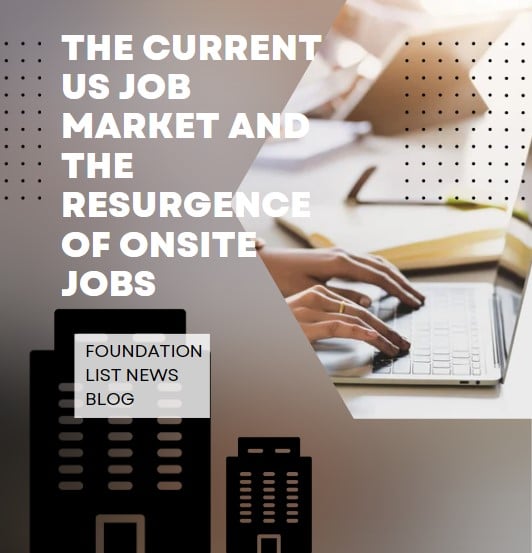In a remarkable turn of events, the US job market has continued its upward trajectory into 2024, defying earlier predictions of a slowdown. This resilience is a testament to the dynamic nature of the economy and the adaptability of businesses and workers alike.
Exceptional Growth in Job Market
The year 2023 ended on a high note with an astonishing increase of 517,000 new jobs, as reported by the New York Times. This surge surpassed all expectations, challenging the notion that the Federal Reserve’s interest rate hikes would dampen employment growth. Instead, the job market witnessed a robust expansion, indicating a strong demand for labor across various sectors.
Onsite Work Makes a Comeback
A significant trend observed in 2024 is the resurgence of onsite jobs. The remote work model, which gained immense popularity during the pandemic, is now witnessing a shift. Employers across the US are increasingly calling their workforce back to the office. This transition is not just a return to pre-pandemic norms but also a response to evolving business needs and employee preferences.
Multiplying Effects on Job Creation
The move to onsite work is not just about filling existing positions. It’s creating a ripple effect, leading to the creation of new job opportunities. As companies reopen their offices, there’s a growing demand for roles that support onsite operations. This includes:
Reception and Office Management: The bustling office environments require efficient management, leading to increased demand for receptionists, office managers, and administrative staff.
Facilities and Technology Services: The need for well-maintained office spaces and up-to-date technology infrastructure has led to more jobs in facilities management and IT support.
Onsite Amenities and Services: With more employees in the office, there’s a surge in demand for onsite amenities like food services, cleaning, and maintenance. This, in turn, opens up various positions in these sectors, contributing further to job market growth.
Forward-Looking Perspective
As we progress through 2024, it’s clear that the US job market is not only resilient but also evolving. The resurgence of onsite jobs is a key aspect of this evolution, offering new opportunities and challenges. Employers and employees alike are adapting to this shift, balancing the benefits of in-person collaboration with the flexibility that remote work offered.
The US job market’s ability to adapt and grow, even in the face of economic uncertainties and shifting work paradigms, remains its strongest suit. Looking ahead, it’s expected that this dynamism will continue to drive employment trends and opportunities, making the job market an exciting space to watch in 2024 and beyond.
The Continued Rise of On-Site and Hybrid Work Models
The landscape of the US job market continues to evolve in 2024, with significant trends shaping the way we work. One of the most notable changes is the ongoing shift towards hybrid work models and the resurgence of onsite jobs. This shift reflects a delicate balance between employer needs and employee preferences, shaping a new normal in the workplace.
Hybrid Work: The New Standard
According to a Resume Builder report, the trend towards hybrid work is not only persisting but also gaining momentum in 2024. An overwhelming majority of employers now require or prefer employees to work from the office part-time. The hybrid model has become a middle ground, offering the benefits of both remote and onsite work. This trend is in response to employee preferences, where only a small fraction (11.6%) desire a full return to the office, as highlighted in a Forbes article. This disparity between employee desires and employer policies has been termed ‘The Great Mismatch’.
Flexibility Remains Key for Workers
The McKinsey study underscores that a staggering 87% of US workers favor flexible office arrangements that blend in-person and virtual work. Similarly, Slack’s research reveals a clear preference for hybrid models among knowledge workers. These studies also highlight the challenges of remote work, such as reduced sense of belonging, while noting that experienced remote workers often report higher satisfaction and productivity levels.
Major Corporations Embrace Onsite Returns
Throughout 2023 and into 2024, a growing number of prominent companies have announced policies bringing staff back to the office in varying capacities. Tech giants, financial institutions, and other large corporations are leading this trend, recognizing the value of onsite interaction while balancing the flexibility that employees seek.
Job Market Defies Recession Fears
The beginning of 2023 set a positive precedent for the job market, with an impressive addition of 517,000 jobs and an unemployment rate hitting a 54-year low at 3.4%. This robust performance, highlighted by Treasury Secretary Janet Yellen’s optimistic outlook, suggests a low likelihood of a recession impacting the job market significantly.
Economic Outlook: A Mixed Bag with Positive Signs
As we delve deeper into 2024, the economic landscape remains somewhat uncertain, yet there are positive indicators. Inflation rates are decelerating, and hiring continues robustly across various sectors. While specific industries like real estate and tech have experienced more layoffs, potentially due to market adjustments or shareholder pressures, the overall job outlook remains strong in the US.
Implications for the Nonprofit Sector
The evolving dynamics of the job market and workplace preferences in 2024 have significant implications for the nonprofit sector, known for its unique challenges and opportunities.
- Adaptation to Hybrid Work Models
Increased Flexibility for Staff: Nonprofits, like their for-profit counterparts, are embracing hybrid work models. This shift allows for greater flexibility in staffing and can be particularly appealing to employees seeking work-life balance, which is often a priority in the nonprofit sector.
Broader Talent Pool: By offering remote work options, nonprofits can tap into a wider talent pool, attracting skilled professionals who may not be in the immediate geographic vicinity but are passionate about the organization’s mission.
- Leveraging Technology for Efficiency
Enhanced Collaboration Tools: With a mix of onsite and remote work, nonprofits need to invest in technology that facilitates collaboration and communication. This can range from project management tools to virtual meeting platforms, ensuring that team members, regardless of location, can work effectively.
Digital Outreach and Fundraising: Nonprofits are increasingly utilizing digital platforms not just for operations, but also for outreach and fundraising. A hybrid work environment can spur more innovative and effective online campaigns, reaching a broader audience.
- Onsite Work for Community Engagement
Localized Impact: For many nonprofits, especially those focused on community work, having an onsite presence is vital. The shift back to onsite work can enhance community engagement and strengthen relationships with local stakeholders.
Event Management and Volunteering: Onsite work is crucial for managing events and coordinating volunteers, which are often key components of nonprofit operations. A balance of onsite and hybrid models can optimize these activities.
- Financial Implications
Cost Efficiency: Hybrid models can help nonprofits save on operational costs, such as office space and utilities, allowing more funds to be directed towards their mission.
Grant and Donor Expectations: Donors and grant-making organizations are increasingly interested in how nonprofits are adapting to the changing work environment. Demonstrating an effective hybrid or onsite strategy can be beneficial in funding applications and donor relations.
- Addressing the ‘Great Mismatch’ in Nonprofits
Aligning Employee Preferences with Mission Goals: Nonprofits must navigate the ‘Great Mismatch’ by aligning employee work preferences with the organization’s mission and operational needs. This may involve creative scheduling, job sharing, and prioritizing employee well-being.
Employee Retention and Satisfaction: By addressing employees’ desires for flexibility and meaningful work, nonprofits can improve retention rates and overall job satisfaction, which is crucial for long-term success.
For the nonprofit sector, the ongoing shifts in the job market present both challenges and opportunities. By embracing hybrid work models, leveraging technology, and maintaining a strong onsite presence when necessary, nonprofits can continue to thrive and make a significant impact in their respective fields. The key will be to balance operational efficiency with employee preferences and the unique demands of nonprofit work.


